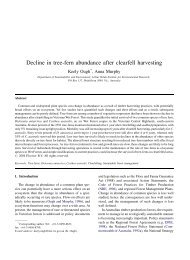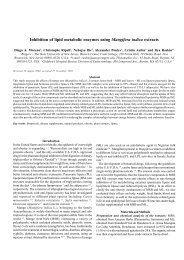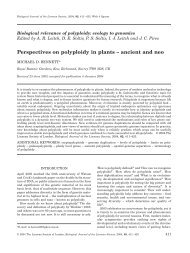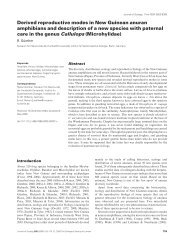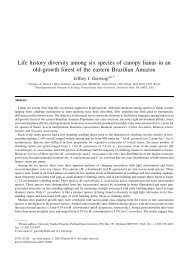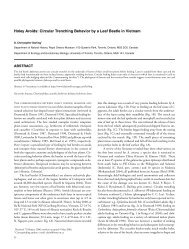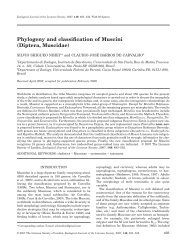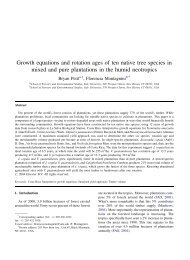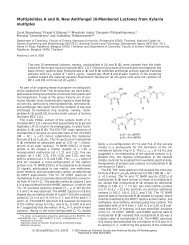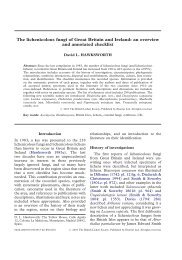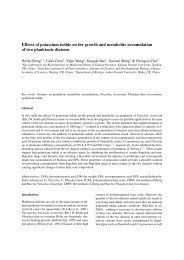Frequency of Cyanogenesis in Tropical Rainforests of Far North ...
Frequency of Cyanogenesis in Tropical Rainforests of Far North ...
Frequency of Cyanogenesis in Tropical Rainforests of Far North ...
You also want an ePaper? Increase the reach of your titles
YUMPU automatically turns print PDFs into web optimized ePapers that Google loves.
Conclusions<br />
In summary, the f<strong>in</strong>d<strong>in</strong>gs <strong>of</strong> this survey <strong>in</strong>dicate that<br />
cyanogenesis is an important, yet little studied, chemical<br />
defence <strong>in</strong> tropical ra<strong>in</strong>forests. The identification <strong>of</strong> specific<br />
cyanogens <strong>in</strong> but a few <strong>of</strong> the cyanogenic species first reported<br />
here has yielded novel f<strong>in</strong>d<strong>in</strong>gs. Given the large number<br />
<strong>of</strong> new reports for species belong<strong>in</strong>g to plant families<br />
or orders <strong>in</strong> which cyanogenesis has been little reported,<br />
the ongo<strong>in</strong>g characterization <strong>of</strong> cyanogenic constituents <strong>in</strong><br />
these species will potentially be <strong>of</strong> both phytochemical and<br />
chemotaxonomic significance. In addition, prelim<strong>in</strong>ary data<br />
on <strong>in</strong>tra-population variation <strong>in</strong> cyanogenesis here suggest<br />
that ontogenetic variation <strong>in</strong> cyanogenesis, and polymorphism<br />
for cyanogenesis merit further <strong>in</strong>vestigation <strong>in</strong> tropical<br />
ra<strong>in</strong>forest species.<br />
ACKNOWLEDGEMENTS<br />
The authors thank Pr<strong>of</strong>essor Eric Conn (University <strong>of</strong><br />
California, Davis) for shar<strong>in</strong>g unpublished data on the<br />
Proteaceae family, Nicole Middleton and volunteers at<br />
the University <strong>of</strong> Melbourne Herbarium for mount<strong>in</strong>g<br />
and databas<strong>in</strong>g specimens, Andrew Ford (CSIRO <strong>Tropical</strong><br />
Forest Research Centre, Atherton, Queensland) for assistance<br />
with species name changes, and Wendy Cooper and<br />
Steve McKenna for additional taxonomic assistance dur<strong>in</strong>g<br />
field work. We also thank Dr John Kanowski (Griffith<br />
University, Queensland) and Andrew Graham (TFRC,<br />
Atherton) for advice <strong>in</strong> the selection <strong>of</strong> field sites, and<br />
Marisa Coll<strong>in</strong>s, Bruce Webber, Ross Waller, Jennifer<br />
Fox, Gav<strong>in</strong> Smith and Joel Youl for assistance <strong>in</strong> the<br />
field. We thank the Australian Canopy Crane Research<br />
Facility for access to forest on the site. Field work was<br />
supported by an Individual Award from the Queen’s<br />
Trust for Young Australians to R.E.M., and was conducted<br />
under the Queensland Department <strong>of</strong> Environment and<br />
Heritage Scientific Purposes Permit number F1/000270/<br />
99/SAA, and Department <strong>of</strong> Natural Resources Permits<br />
to Collect numbers 1542, 1716, 1409 and 1663.<br />
LITERATURE CITED<br />
Adsersen A, Adsersen H. 1993. Cyanogenic plants <strong>in</strong> the Galapagos<br />
Islands: ecological and evolutionary aspects. OIKOS 66: 511–520.<br />
Adsersen A, Adsersen H, Brimer L. 1988. Cyanogenic constituents <strong>in</strong><br />
plants from the Galapagos Islands. Biochemical Systematics and<br />
Ecology 16: 65–77.<br />
Aikman K, Bergman D, Eb<strong>in</strong>ger J, Seigler D. 1996. Variation <strong>of</strong><br />
cyanogenesis <strong>in</strong> some plant species <strong>of</strong> the Midwestern United States.<br />
Biochemical Systematics and Ecology 24: 637–645.<br />
Brimer L, Cical<strong>in</strong>i AR, Federici F, Petruccioli M. 1995. Beta-glycosidase<br />
as a side activity <strong>in</strong> commerical pect<strong>in</strong>ase preparations <strong>of</strong> fungal<br />
orig<strong>in</strong>. The hydrolysis <strong>of</strong> cyanogenic glycosides. Italian Journal <strong>of</strong><br />
Food Sciences 4: 387–394.<br />
Br<strong>in</strong>ker AM, Seigler DS. 1989. Methods for the detection and quantitative<br />
determ<strong>in</strong>ation <strong>of</strong> cyanide <strong>in</strong> plant materials. Phytochemical Bullet<strong>in</strong><br />
21: 24–31.<br />
Buhrmester RA, Eb<strong>in</strong>ger JE, Seigler DS. 2000. Sambunigr<strong>in</strong> and<br />
cyanogenic variability <strong>in</strong> populations <strong>of</strong> Sambucus canadensis<br />
L. Caprifoliaceae. Biochemical Systematics and Ecology 28: 689–695.<br />
Cant<strong>in</strong>o PD. 1992. Evidence for a polyphyletic orig<strong>in</strong> <strong>of</strong> the Labiatae.<br />
Annals <strong>of</strong> the Missouri Botanical Garden 79: 361–379.<br />
CFSAN Centre for Food Safety and Applied Nutrition. 2003. US<br />
Department <strong>of</strong> Health and Human Services Poisonous Plant Database.<br />
http://www.cfsan.fda.gov/djw/plantox.html. Accessed: 16 October<br />
2003.<br />
Chase MW, Zmarzty S, Lledo MD, Wurdack KJ, Swensen SM,<br />
Fay MF. 2002. When <strong>in</strong> doubt, put it <strong>in</strong> Flacourtiaceae: a molecular<br />
phylogenetic analysis based on plastid rbcL DNA sequences. Kew<br />
Bullet<strong>in</strong> 57: 141–181.<br />
Chassagne D, Crouzet J, Bayonove CL, Baumes RL. 1996. Identification<br />
and quantification <strong>of</strong> passion fruit cyanogenic glycosides. Journal <strong>of</strong><br />
Agricultural and Food Chemistry 44: 3817–3820.<br />
Coley PD. 1983. Herbivory and defensive characteristics <strong>of</strong> tree species <strong>in</strong> a<br />
lowland tropical ra<strong>in</strong>forest. Ecological Monographs 53: 209–233.<br />
Coley PD. 1988. Effects <strong>of</strong> plant growth rate and leaf lifetime on the amount<br />
and type <strong>of</strong> anti-herbivore defense. Oecologia 74: 531–536.<br />
Coley PD, Barone JA. 1996. Herbivory and plant defenses <strong>in</strong> tropical<br />
forests. Annual Review <strong>of</strong> Ecology and Systematics 27: 305–335.<br />
Coley PD, Kursar TA. 1996. Anti-herbivore defenses <strong>of</strong> young tropical<br />
leaves: physiological constra<strong>in</strong>ts and ecological trade-<strong>of</strong>fs. In:<br />
Mulkey SS, Chazdon RL, Smith AP, eds. <strong>Tropical</strong> forest plant ecophysiology.<br />
New York: Chapman and Hall, 305–336.<br />
Coley PD, Bryant JP, Chapp<strong>in</strong> FS, III. 1985. Resource availability and<br />
plant antiherbivore defense. Science 230: 895–899.<br />
Coll<strong>in</strong>s DJ, Culvenor CCJ, Lamberton JA, Loder JW, Price JR. 1990.<br />
Plants for medic<strong>in</strong>es: a chemical and pharmacological survey <strong>of</strong><br />
plants <strong>in</strong> the Australian region. Melbourne: CSIRO Publications.<br />
Conn EE. 1981. Cyanogenic glycosides. In: Conn EE, ed. The biochemistry<br />
<strong>of</strong> plants. New York: Academic Press Inc., 479–499.<br />
Conn EE. 1991. The metabolism <strong>of</strong> a natural product: lessons learned<br />
from cyanogenic glycosides. Planta Medica 57: S1–S9.<br />
Conn EE, Masl<strong>in</strong> BR, Curry S, Conn ME. 1985. <strong>Cyanogenesis</strong> <strong>in</strong><br />
Australian species <strong>of</strong> Acacia. Survey <strong>of</strong> herbarium specimens and<br />
liv<strong>in</strong>g plants. Western Australian Herbarium Research Notes 10: 1–13.<br />
Cooper W, Cooper WT. 1994. Fruits <strong>of</strong> the ra<strong>in</strong> forest. A guide to fruits<br />
<strong>in</strong> Australian tropical ra<strong>in</strong> forests. Surry Hills, NSW, Australia:<br />
RD Press.<br />
Cooper-Driver GA, F<strong>in</strong>ch S, Swa<strong>in</strong> T. 1977. Seasonal variation <strong>in</strong> secondary<br />
plant compounds <strong>in</strong> relation to the palatability <strong>of</strong> Pteridium<br />
aquil<strong>in</strong>um. Biochemical Systematics and Ecology 5: 177–183.<br />
Cronquist A. 1981. An <strong>in</strong>tegrated system <strong>of</strong> classification <strong>of</strong> flower<strong>in</strong>g<br />
plants. New York: Columbia University Press.<br />
Dahler JM, McConchie CA, Turnbull CGN. 1995. Quantification <strong>of</strong><br />
cyanogenic glycosides <strong>in</strong> seedl<strong>in</strong>gs <strong>of</strong> three Macadamia Proteaceae.<br />
species. Australian Journal <strong>of</strong> Botany 43: 619–628.<br />
Davies AG, Bennett EL, Waterman PG. 1988. Food selection by two<br />
South-east Asian colob<strong>in</strong>e monkeys Preshytis rubicunda and<br />
Presbytis melalophos <strong>in</strong> relation to plant chemistry. Biological Journal<br />
<strong>of</strong> the L<strong>in</strong>nean Society 34: 33–56.<br />
Dement WA, Mooney HA. 1974. Seasonal variation <strong>in</strong> the production<br />
<strong>of</strong> tann<strong>in</strong>s and cyanogenic glycosides <strong>in</strong> the Chaparral shrub,<br />
Heteromeles arbutifolia. Oecologia 15: 65–76.<br />
Dickenmann R. 1982. <strong>Cyanogenesis</strong> <strong>in</strong> Ranunculus montanus s.l. from the<br />
Swiss Alps. Bericht des Geobotanischen Institutes ETH 49: 56–75.<br />
Everist SL. 1981. Poisonous plants <strong>of</strong> Australia. Sydney, Australia: Angus<br />
and Robertson.<br />
Eyjólfsson R. 1971. Constitution and stereochemistry <strong>of</strong> lucum<strong>in</strong>, a<br />
cyanogenic glycoside from Lucuma mammosa Gaertn. Acta Chemica<br />
Scandanavia 25: 1898–1900.<br />
Feeny P. 1976. Plant apparency and chemical defense. In: Wallace JW,<br />
Mansell RL, eds. Biochemical <strong>in</strong>teraction between plants and<br />
<strong>in</strong>sects. New York: Plenum Press, 1–40.<br />
Feigl F, Anger V. 1966. Replacement <strong>of</strong> benzid<strong>in</strong>e by copper ethylacetoacetate<br />
and tetra base as spot-test reagent for hydrogen cyanide and<br />
cyanogen. Analyst 91: 282–284.<br />
Fikenscher LH, Hegnauer R. 1977. Cyanogenese bei den Cormophyten.<br />
12. Mitteilung. Chaptalia nutans, e<strong>in</strong>e stark cyanogene Planze<br />
Brasiliens. Planta Medica 31: 266–269.<br />
F<strong>in</strong>nemore H, Cooper JM. 1936. Cyanogenetic glucosides <strong>in</strong> Australian<br />
plants. Part 4—Zieria laevigata. Journal <strong>of</strong> the Royal Society <strong>of</strong><br />
New South Wales 70: 175–182.<br />
F<strong>in</strong>nemoreH, CooperJM. 1938. The cyanogenic constituents <strong>of</strong> Australian<br />
and other plants. Journal <strong>of</strong> the Society <strong>of</strong> Chemistry and Industry 57:<br />
167–169.



